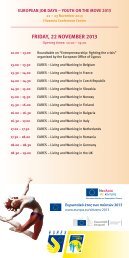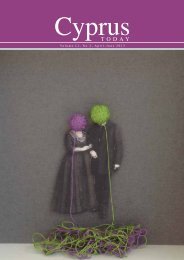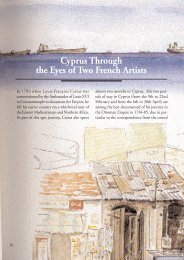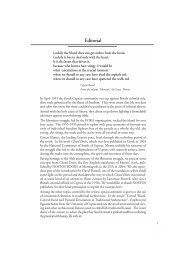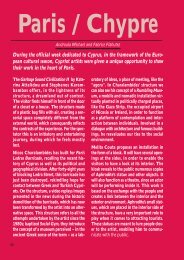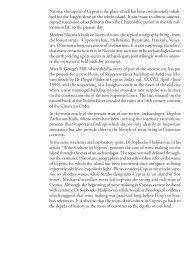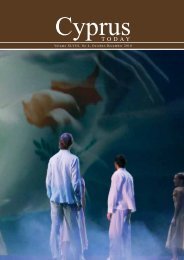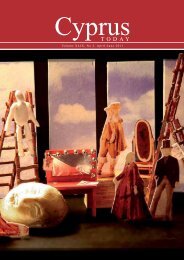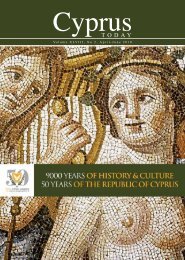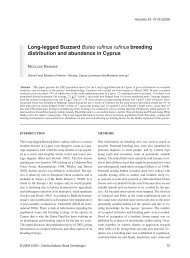Editorial
Editorial
Editorial
Create successful ePaper yourself
Turn your PDF publications into a flip-book with our unique Google optimized e-Paper software.
26<br />
a conscious attempt by the artists to rightly<br />
depict perspective space and the third dimension<br />
both with respect to the volume of the<br />
figures and of the buildings. The composition<br />
of space and the use of perspective is connected<br />
to the so-called "first Renaissance of Masaccio<br />
and Beato Angelico", as in the icon of the<br />
Communion of the Apostles from the Church<br />
of Our Lady Chrysaliniotissa (today at BMAMF)<br />
and the fresco of the 18th Oikos of the Akathistos<br />
Hymn at the Latin Chapel of the Monastery<br />
of St. John Lambadistis. Amongst the novel<br />
subjects imported during this period is the<br />
depiction of St. Anna with the Mother of God<br />
Holding the Child Christ, as, for example, in<br />
the fresco from the Church of St. George<br />
Exorinos in Ammochostos, the depictions<br />
of the Virtues (Justice, Love, Faith, Charity,<br />
and others) both at Chrysopantanassa at Palaichori<br />
and the Church of Our Lady at Choulos.<br />
Renaissance, Italian standards are also followed<br />
at the Latin Chapel of the Monastery<br />
of Lambatistis at Kalopanagiotis, which we<br />
believe dates around 1500, for the scene of<br />
the Hospitality of Abram and the Birth of<br />
Christ in the 8th Oikos, as can also be seen<br />
in later day engraving, 1555, which reproduce<br />
a common, older, unidentified until today,<br />
standard. Similar engravings were also utilized<br />
by the painter of Timios Prodromos (St. John<br />
Prodromos) at Askas for the scene of the Apotomi<br />
of the Skull of the Saint, as in the<br />
engraving by Israel von Mechenen, which is<br />
dated around 1480.<br />
Other imported subjects, besides the western<br />
Man of Sorrows, with Christ laying dead in<br />
front of His sarcophagus are the depictions of<br />
the so-called western type Resurrection, with<br />
Christ Rising from the grave holding a banner,<br />
labarum or the Pietà, as in the icon<br />
from Pera Chorio of Cyprus, now at BMAMF.<br />
The portrayal of the Mother of God Holding<br />
the Child Christ was one of the most popular<br />
subjects both in the East and West. As it<br />
can be seen, icons of the Mother of God were<br />
exported from Cyprus at the end of the<br />
13th century with the Crusaders and during<br />
the Venetian rule with depictions of the Virgin<br />
Mary as the western Madonna. The icons<br />
of the Madonneri, Madre della Consolazione,<br />
Madre Misericordia and Mater Lactans<br />
were very popular in Cyprus and were intended<br />
mainly for the Latin Churches on the island<br />
and for private individuals. They are works of<br />
art that exhibit an intense presence of western<br />
iconographic elements and can be met<br />
throughout the Greek-Orthodox region. The<br />
large number of such works in Cyprus cannot<br />
preclude the existence of Madonneri workshop<br />
in the island, which produced and traded<br />
icons and was one of the workshops founded<br />
in territories under the Venetian rule.<br />
The looting and slaughter that ensued the<br />
conquest of Cyprus by the Ottomans in 1571<br />
forced a lot of Cypriot artists to seek refuge<br />
in Venice, artists such as Ioannis Cypriot, who<br />
painted the cupola and other parts of the<br />
Church of St. George of the Greeks in Venice,<br />
painter Peter who, according to a document<br />
held in the Venetian archives, was captured<br />
by the Turks with his family and another<br />
painter, Domenico the Cypriot, a member of<br />
the Greek Brotherhood of Venice.<br />
The decrease of artistic production in Cyprus<br />
during the first decades of the Turkish rule of<br />
the island, which is attributed mainly to the<br />
immigration of many painters, was countered<br />
with the import of icons from Venice and the<br />
Greek territories that were under Venetian<br />
rule, such as Crete and the Ionian Islands.<br />
One characteristic example is the icon of the<br />
Mother of God Enthroned, now belonging<br />
to the collection of the BMAMF, which was<br />
sent by the priest of the church of St. George



